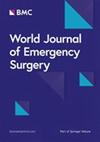Prediction of infected pancreatic necrosis in patients with acute necrotizing pancreatitis based on ensemble machine learning model.
IF 5.8
1区 医学
Q1 EMERGENCY MEDICINE
引用次数: 0
Abstract
BACKGROUND To study the value of ensemble machine learning (EL) model in the prediction of infected pancreatic necrosis (IPN) among patients with acute necrotizing pancreatitis (ANP). METHODS This study comprehensively analyzed 1073 acute necrotizing pancreatitis (ANP) patients admitted to Xiangya hospital from January 2011 to December 2023. The patients were divided into IPN group and sterile pancreatic necrosis (SPN) group based on IPN occurrence. All ANP patients were randomly divided into training dataset and validation dataset with a ratio of 7:3. The EL model was built by integrating multiple machine learning models (LASSO, random forest, and SVM). To verify the stability of the EL model, 78 ANP patients from the Third Xiangya hospital were included for external validation, and a Fagan nomogram was constructed to assess the posterior probability. RESULTS The EL model was constructed with 31 risk factors identified through LASSO regression. The prediction accuracy of the EL model in the training dataset was 92.6%. In the validation dataset, the prediction accuracy was 91.5%. Compared with the LR model, the EL model demonstrated higher AUC values (training dataset: 0.916 vs. 0.744; validation dataset: 0.919 vs. 0.742) and net benefit rate. The AUC of the EL model for predicting IPN within 7 days, 7-14 days, and after 14 days were 0.888, 0.906, and 0.901, respectively. In addition, the external validation results further indicated the accuracy of the EL model (AUC: 0.883). An EL model-based Fagan nomogram could be used to estimate the accuracy of IPN predictions. CONCLUSION The EL model demonstrates superior predictive efficiency for IPN compared to the LR model, offering greater predictive value and potential clinical benefits. Furthermore, the EL model shows stable performance across different stages of IPN onset, enabling clinicians to make timely adjustments to treatment strategies and ultimately improve patient outcomes. TRIAL REGISTRATION The study is registered at www.researchregistry.com (Unique Identifying number: researchregistry10652).基于集成机器学习模型的急性坏死性胰腺炎患者感染性胰腺坏死预测。
背景研究集成机器学习(EL)模型在急性坏死性胰腺炎(ANP)患者感染性胰腺坏死(IPN)预测中的价值。方法对2011年1月至2023年12月湘雅医院收治的1073例急性坏死性胰腺炎(ANP)患者进行综合分析。根据IPN的发生情况将患者分为IPN组和无菌胰腺坏死(SPN)组。所有ANP患者随机分为训练数据集和验证数据集,比例为7:3。结合LASSO、随机森林、SVM等多个机器学习模型构建EL模型。为了验证EL模型的稳定性,选取湘雅第三医院的78例ANP患者进行外部验证,并构建Fagan nomogram来评估后验概率。结果通过LASSO回归,确定了31个危险因素,构建了EL模型。EL模型在训练数据集中的预测准确率为92.6%。在验证数据集中,预测准确率为91.5%。与LR模型相比,EL模型的AUC值更高(训练数据集:0.916 vs. 0.744;验证数据集:0.919 vs. 0.742)和净效益率。EL模型预测7 d、7 ~ 14 d和14 d后IPN的AUC分别为0.888、0.906和0.901。此外,外部验证结果进一步验证了EL模型的准确性(AUC: 0.883)。基于EL模型的Fagan模态图可以用来估计IPN预测的准确性。结论与LR模型相比,EL模型对IPN的预测效率更高,具有更高的预测价值和潜在的临床效益。此外,EL模型在IPN发作的不同阶段表现稳定,使临床医生能够及时调整治疗策略,最终改善患者的预后。试验注册本研究注册在www.researchregistry.com(唯一识别码:researchregistry10652)。
本文章由计算机程序翻译,如有差异,请以英文原文为准。
求助全文
约1分钟内获得全文
求助全文
来源期刊

World Journal of Emergency Surgery
EMERGENCY MEDICINE-SURGERY
CiteScore
14.50
自引率
5.00%
发文量
60
审稿时长
10 weeks
期刊介绍:
The World Journal of Emergency Surgery is an open access, peer-reviewed journal covering all facets of clinical and basic research in traumatic and non-traumatic emergency surgery and related fields. Topics include emergency surgery, acute care surgery, trauma surgery, intensive care, trauma management, and resuscitation, among others.
 求助内容:
求助内容: 应助结果提醒方式:
应助结果提醒方式:


